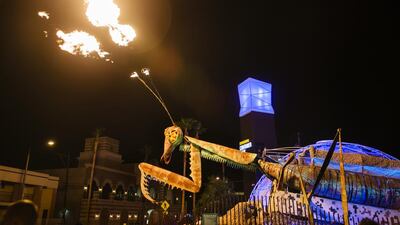On Fremont Street, a 12-metre-tall model of a praying mantis kicks into action, shooting flames into the night sky, six storeys high.
It is, apparently, a functioning road vehicle, and has been programmed to speak in more than 20 languages. A team of four is required to operate it, and a drum circle gathers around as the fire billows upwards. They issue the “Call to the mantis”, inviting bemused passers-by to join in.
The massive mantis – a precise 150:1 scale model built from scrap metal – guards the entrance to the Downtown Container Park. Here, hundreds of shipping containers have been repurposed by gourmet hot-dog creators, jewellery designers, quirky toymakers and independent fashionistas. All have limited but, crucially, cheap, space to experiment with what they’re passionate about and attempt to carve a business from it. This feels like it should be somewhere like Austin, Texas, or Portland, Oregon, with a hipsterish, slavishly artisan vibe going off that fits a self-consciously liberal, homespun-celebrating bastion of boutiquery. Instead, it’s in the high temple of gargantuan, hyperbranded excess, Las Vegas.
The Strip – more formally, Las Vegas Boulevard – is what Las Vegas is known for. It’s flanked by giant fun palaces hosting thousands of hotel rooms, as well as Jennifer Lopez concerts, Cirque du Soleil spectaculars and in-resort roller coasters. Size and spectacle is everything. But that’s just part of the Vegas experience, not the entirety. Downtown, there’s a different story.
One of the more-recent successes in this formerly down-at-heel part of the city is the Fremont Street Experience – a gaudy open-air, multi-block festival of bright lights, neon, street entertainers and country music acts on stages. It doesn’t have the gloss of the Strip, but it has the party spirit.
But what has changed even more recently lies just to the east of this LED-lit nightly carnival. The downtown area is rapidly changing from a no-go zone to that rarest of things in Vegas – somewhere that feels part of the real world. Head along Carson Street or Fremont Street East towards the container park, and what strikes you is the number of cafes and restaurants that are small, independent and doing their own thing. Most are owned by chefs who have done their time in the big resorts and wanted to go somewhere where repeat custom and a local feel are a possibility. The likes of Carson Kitchen, which goes in for unashamedly rich dishes, but without the unashamedly rich decor, wouldn’t work on the Strip.
The area is also beginning to blossom culturally, and this is partly down to a conscious effort to cultivate street art. A few blocks that would make for wary walking two or three years ago have been brought to life with massive murals. Most come courtesy of international artists, who were first invited over for the now-annual Life Is Beautiful festival in 2013.
The collection of often detailed and political art has mushroomed across once-empty walls. Some murals go for bleakness – such as a snail with a human head for a shell being pecked by birds; others for slightly bizarre whimsy – a woman on a beach surrounded by rabbits.
While the downtown streets have been made far more enjoyable to walk around, there have also been big new additions to make the area a tourist attraction in its own right. Most prominent of these is The Mob Museum, which delves into a side of Las Vegas history that is often uncomfortable for the city to admit.
In the early days of the city’s rise from desert nowhere to world fun capital, it was usually the mafia and their associates who controlled the money and development. Mob members branched out here from established pods in the major cities around the United States, and they found considerable success. The museum brings in the back story of how scions from New York and Chicago dynasties were sent to make and launder money, but also goes into efforts to bring the mobsters under control and – eventually – to justice. It’s not a quick dash through, either – the detail is laid on thick and brought to life. There’s many a crime-thriller movie to be made in the stories.
Getting beyond the Strip isn’t just about going downtown, though. Las Vegas is beginning to realise its natural charms, and nowhere is this more apparent than Red Rock Canyon.
The surrounding peaks have saw teeth, and the burning reds of the landscape come from iron in a rock bed that was once the sea floor. A few hardy shrubs and cacti grow on the canyon sides, but it’s the starkness that grabs the attention.
The circular track through this landscape does some considerable climbing, and is best tackled on an e-bike. Whack the assistance setting to the top level and suddenly everything seems dandy. The downhill stretches, meanwhile, are tremendous for picking up speed and feeling the desert breeze through your hair.
But the intrigue comes on the flat. At Willow Springs, a small oasis where trees take the place of struggling, stunted bushes, the rocks come with giant purple-black swirls. Within them are red handprints alongside other rudimentary paintings. No one quite knows who made them. The indigenous Southern Paiute people who traditionally inhabit the area say it’s not their handiwork – meaning that the art has probably come from a tribe that lived in the Red Rock areas a couple of thousand years ago.
Las Vegas may be a brash new city that’s only just beginning to look at its history through The Mob Museum, but away from the Strip, there are traces that go back a lot further.
travel@thenational.ae

